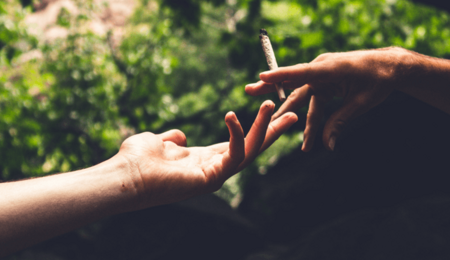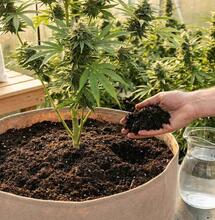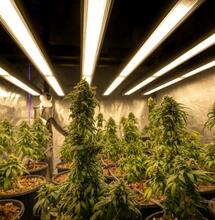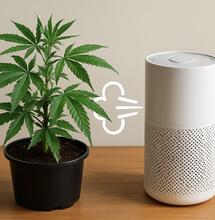Spring Planting and Greenhouses

By capturing and storing available heat, growing seasons can be extended - even if outdoor temperatures are below a plant's tolerance.
By capturing and storing available heat, growing seasons can be extended - even if outdoor temperatures are below a plant's tolerance.
The Spring
The Spring Equinox for the Northern Hemisphere is around March 20th, when both the days and nights are about 12 hours long. The nights then get progressively longer until around June 21st when, for much of the United States, the days reach approximately 14.5 hours long. After that, they get shorter again until the Autumn Equinox, when the days and nights are again 12 hours each. Since Cannabis plants set out under 12/12 lighting will flower, outdoor gardeners (unless looking for a quick spring crop) wait until mid-April or May to set out their plants, outdoor conditions permitting. Even when outdoor conditions aren't ideal, the growing season can often be started with the use of cloches, hoop houses, cold frames, hotboxes, greenhouses or hothouses. Sunlight is comprised of a wide range of electromagnetic radiation. Plants make use of both visible light (for photosynthesis) and infrared (heat). Full summer sunlight has approximately 400 to 450 watts of visible light, and over 500 watts of infrared energy per square meter. In comparison, a 400-watt HPS light is about 20% efficient for visible light, so it would take five to six per square meter to get the equivalent visible light, and there would be a huge excess of infrared. Even the mighty 1,000-watt HIDs would need two or three per square meter to bring the same light indoors. Outdoor gardens enjoy free light and heat, which can greatly reduce the expense in the cost of growing your smoke.
By capturing and storing available heat, growing seasons can be extended - even if outdoor temperatures are below a plant's tolerance. One simple way to trap the heat from the sun is to paint an object black. A black object will absorb more infrared radiation than a white object will. White will reflect much of the heat (and light), and thus stay cooler in comparison. Sunlight striking a black surface will release its infrared radiation into the surface, warming it and its contents. Soil solarization uses this principle to raise soil temperatures high enough to kill most weed seeds and other pathogens. Black sheets of plastic are used to cover soil under summer sunlight. The sunlight heats the plastic, and the air trapped under it, bringing temperatures high enough to kill most seeds and many harmful disease spores.
Sunlight is comprised of a wide range of electromagnetic radiation. Plants make use of both visible light (for photosynthesis) and infrared (heat). Full summer sunlight has approximately 400 to 450 watts of visible light, and over 500 watts of infrared energy per square meter. In comparison, a 400-watt HPS light is about 20% efficient for visible light, so it would take five to six per square meter to get the equivalent visible light, and there would be a huge excess of infrared. Even the mighty 1,000-watt HIDs would need two or three per square meter to bring the same light indoors. Outdoor gardens enjoy free light and heat, which can greatly reduce the expense in the cost of growing your smoke.
By capturing and storing available heat, growing seasons can be extended - even if outdoor temperatures are below a plant's tolerance. One simple way to trap the heat from the sun is to paint an object black. A black object will absorb more infrared radiation than a white object will. White will reflect much of the heat (and light), and thus stay cooler in comparison. Sunlight striking a black surface will release its infrared radiation into the surface, warming it and its contents. Soil solarization uses this principle to raise soil temperatures high enough to kill most weed seeds and other pathogens. Black sheets of plastic are used to cover soil under summer sunlight. The sunlight heats the plastic, and the air trapped under it, bringing temperatures high enough to kill most seeds and many harmful disease spores.
Lights
While black is an ideal color for collecting and storing solar heat, it is opaque to (blocks) visible light. Covering a plant with a sheet of black plastic would help keep it warm, but the plant would die from lack of visible light. Since plants need both visible light and infrared radiation to survive, the material covering the plants should not only be at least semi opaque to infrared light, but transparent to visible light. If an elevated transparent material is used, the amount of heat that is collected and trapped is reduced, but the visible light that plants need to grow can pass though. This is why glass, plastic sheeting, and other clear materials are used when trapping solar radiation for plants. As long as the structure absorbs heat faster than it loses heat, it will enjoy a net gain, and internal temperature will rise. In this way, the structure can absorb heat during the day, and release it during the cold hours of night. The smaller the area covered, the less-buffered temperature fluctuations are. A small object heated by the sun will cool faster than a large object heated by the sun, due to the difference in mass. So cloches will not store heat as well overnight as a full greenhouse will.
Cloches
Small cloches can help protect small spring seedlings. Originally made of glass; these bell shaped domes were placed on seedlings to protect them. Today, most cloches are made of plastic. To make an inexpensive cloche for a single seedling, cut the bottom off of a two-liter clear plastic soda bottle, and use to cover. Careful use of a hot soldering iron can make neat holes in the sides. This can help protect the tender sprout from the elements, and the cloche will help keep it warm and humid inside. A larger cloche can be made for a section of the garden by building a simple frame, and covering it with transparent poly sheeting. This style of cloche is often homemade, using a simple wooden or PVC frame. Hoop houses are a common style of large cloche, and can be made at home. To make a hoop house wooden boards or PVC are bent into 'D' shapes, and then raised into place and attached to each other. This frame is used to hold an outer transparent layer of sheeting. Southern or southeastern exposures are well suited for taking advantage of solar heat and light collection. When larger cloches cover entire rows of plants, they are known as high tunnels or row covers. A small, rigid-framed structure that uses this same principle is a cold frame. A sturdier and more permanent version of a cloche, cold frames are usually wooden-sided boxes with transparent tops. Light passes through to the plants, but some of the heat is trapped inside. Cold frames can be used to start seedlings before transplanting outside, or used as a staging area for indoor grown plants to help them harden off.
By placing indoor grown plants into a protected cold frame, environmental changes can be introduced in steps, reducing the likelihood of shock. A greenhouse is a larger, clear-walled version of a cold frame. A greenhouse that functions well enough to maintain growing temperatures in winter months, either through efficiency or additional heat sources, is known as a hothouse. Winter Cannabis gardens often are either started indoors and moved out to the greenhouse for flowering, or additional lights are used to prevent flowering while plants grow vegetatively in the greenhouse.
A small, rigid-framed structure that uses this same principle is a cold frame. A sturdier and more permanent version of a cloche, cold frames are usually wooden-sided boxes with transparent tops. Light passes through to the plants, but some of the heat is trapped inside. Cold frames can be used to start seedlings before transplanting outside, or used as a staging area for indoor grown plants to help them harden off.
By placing indoor grown plants into a protected cold frame, environmental changes can be introduced in steps, reducing the likelihood of shock. A greenhouse is a larger, clear-walled version of a cold frame. A greenhouse that functions well enough to maintain growing temperatures in winter months, either through efficiency or additional heat sources, is known as a hothouse. Winter Cannabis gardens often are either started indoors and moved out to the greenhouse for flowering, or additional lights are used to prevent flowering while plants grow vegetatively in the greenhouse.
Greenhouses
An advantage to greenhouses is that not only can they be used to warm plants in cooler months, they can be cooled to reduce internal temperatures in summer. Greenhouses often have windows that can be opened to release excess heat in the summer, and sometimes fans are added for greater control. Greenhouses can range in size from a handful of feet to huge commercial warehouse-sized structures. Fear of theft or discovery prevents many gardeners from taking advantage of natural sunlight in their gardens, but for those fortunate enough to be able to use it, simple greenhouse technology can provide plants in less-than-ideal environments a way to make use of the sun. Peace, love and puka shells, Grubbycup
S
Soft Secrets



